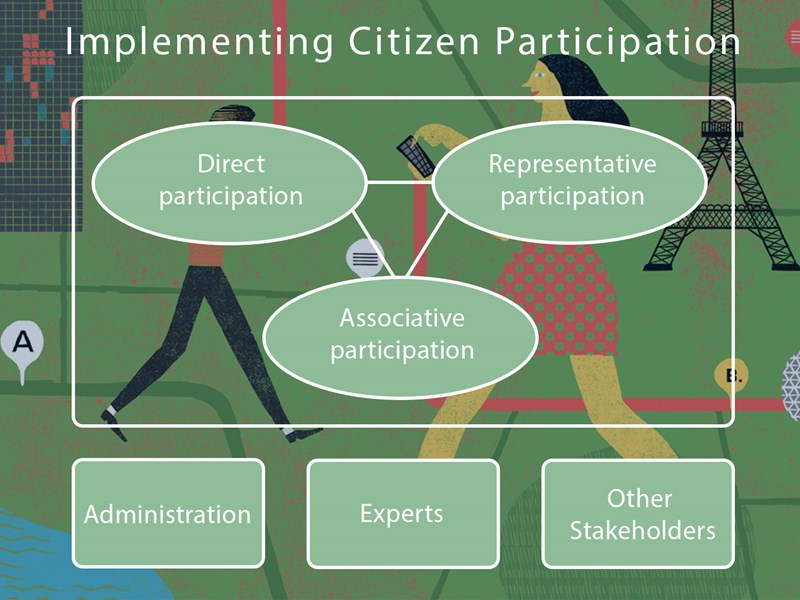IPM Launches the Citizen Participation Network

IPM kicked off the Citizen Participation Network, led by Director Professor Ares Kalandides last week, building on a similar webinar series delivered in Greek over the last couple of months. The first in the series bought together practitioners and academics to discuss the varied debates and methods within Citizen Participation.
Ares set the scene explaining the aim of the network was to bring together people involved in citizen participation, gaining different insights and perspectives and exploring possible collaboration going forward.
Following his short introduction, Ares discussed the theoretical background for Citizen Participation. The sectors that partake and deal with citizen participation are wide-ranging including architecture, planning, governance, placemaking and place management. This makes the concept of Citizen Participation complex as each group views, interprets and delivers it differently. There are different modes of participation – representative, direct and associational. Formats also vary, and include citizen assemblies, referendums, public hearings, as well as activism such as social movements and citizen initiatives. Ares went to explore key questions; who participates? What are the barriers to participation? With participation and engagement varying based on gender, ethnicity, origin and class. The presentation ended with a model for implementing effective citizen participation, something that Ares looks to discuss and develop further throughout the webinar series.
Next up, Charles Campion partner at JTP, went on to discuss collaborative placemaking in practice. Charles explained collaborative placemaking involves multiple stages of engagement and participation, putting people at the heart of the creative process and ensuring numerous opportunities for feedback throughout any given project. Charles stated you often have to ‘seek out the community’ and be flexible within the participation process in order to meet the needs of the stakeholders within a place. Charles discussed various projects and visions he has been involved in and led including the Liskeard Cattle Market, as part of MHCLG’s exemplar charrette (an intense period of design/planning activity) initiative, Scarborough’s Renaissance, Big Barnes Ponder and Tampere WEST+, Finland. With all the projects highlighting different ways and methods of effective citizen participation in practice. Charles ended with a quote ‘never underestimate the power and the reach of activated, motivated citizens to sort out a town’.
Dr Mark Hammond, Senior Lecturer at the Manchester School of Architecture followed detailing the project ‘Manchester Age-Friendly Neighbourhoods’ (MAFN) which he has been involved in for the last four years. Mark’s research interest focuses on older people’s experience of the urban environment ranging from the home to the city. Mark explained older people are often marginalised, however, he stated it is a product of systemic disempowerment, rather than individual weakness in the older generation. The overall aim of MAFN was to transform existing relationships between institutions and residents to overcome marginalisation and disengagement within communities. The project focussed on four different districts centres within Manchester; Burnage, Hulme and Moss Side, Miles Platting and Moston. Mark mentioned there were three core principles to the project; partnership working, action planning methodology and co-create projects. Over the course of the project completed earlier this year, it successfully created a resident-led partnership in each location, had over 5,000 conversations with residents and spent at £136k on small projects driven by the resident boards in each place.
Eleanor Radcliffe, Researcher at CLES, concluded the presentations discussing citizen participation and UK local government. Eleanor discussed the work CLES has done with local authorities (LAs) highlighting trends, challenges and gaps in the participation process within local government. Eleanor stated LAs often utilise participation methods such as co-production and consultation, which are deemed to be tokenistic on the ladder of participation (Arnstein, 1967). Eleanor argues she believes there is an opportunity for LAs to connect and engage with communities on a deeper level to ensure local places work for the people that live there. Covid-19 has seen engagement within local communities gain interest and appears to be a focus for LAs going forward as they look to recover from the pandemic. Eleanor argued that engagement is often used to validate decisions that have already been made rather than organically grow ideas and plans involving citizens from the start of the process. In addition, Eleanor added councils are often restricted by time, funds, lack of specific skills and multiple other demands leading to poorly thought out and rushed engagement and participation processes. Eleanor argued that historically poor participatory process for citizens has led to disconnect and lack of trust between the community and LA in many places.
Following the presentations, speakers took a range of questions and discussion points from the audience. Discussion points included the most recent white paper on planning reform, how to break down barriers and conflicts within communities through participation and the different ways citizens participate and engage.
Click here to watch a full recording of the webinar.
The next session will take place on 25th November, with speakers Vidhya Alakeson (Power to Change) and Phil Prentice (Scotland's Towns Partnership) already confirmed. Click here to register for the event.
References
Arnstein, S.R. (1969) A ladder of citizen participation. Journal of the American Institute of Planners, 35(4), pp. 216–224.
